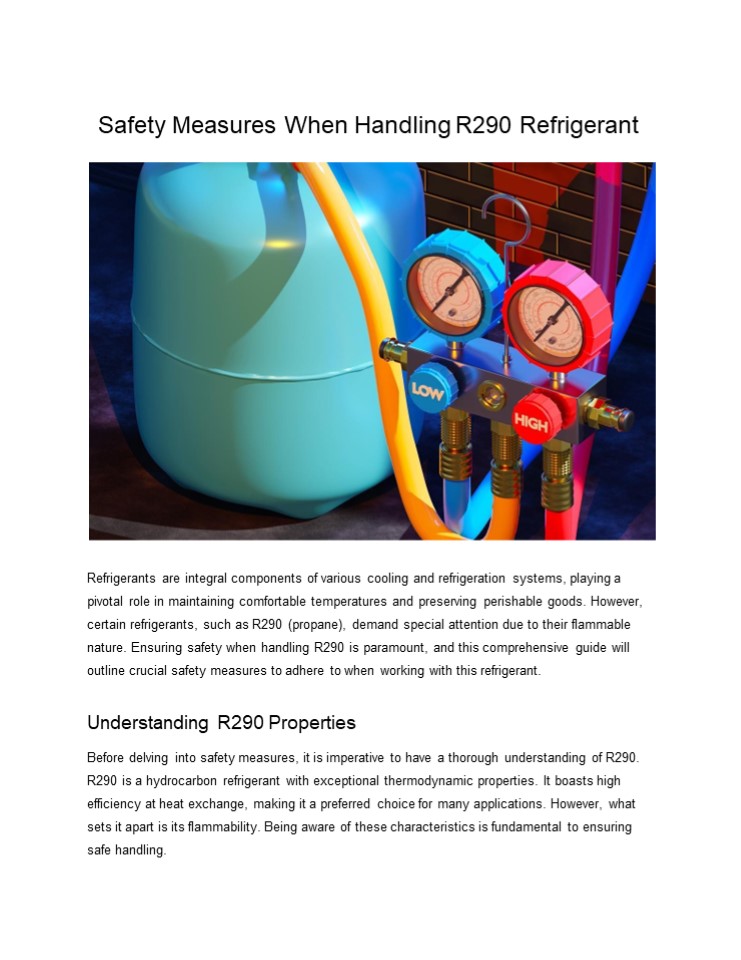Safety Measures When Handling R290 Refrigerant - PowerPoint PPT Presentation
Title:
Safety Measures When Handling R290 Refrigerant
Description:
Learn essential safety measures for handling R290 refrigerant, a flammable but efficient cooling agent. Discover how proper training, ventilation, PPE, and more ensure safe refrigerant management in this comprehensive guide. – PowerPoint PPT presentation
Number of Views:28
Title: Safety Measures When Handling R290 Refrigerant
1
Safety Measures When Handling R290 Refrigerant
Refrigerants are integral components of various
cooling and refrigeration systems, playing a
pivotal role in maintaining comfortable
temperatures and preserving perishable goods.
However, certain refrigerants, such as R290
(propane), demand special attention due to their
flammable nature. Ensuring safety when handling
R290 is paramount, and this comprehensive guide
will outline crucial safety measures to adhere
to when working with this refrigerant. Understand
ing R290 Properties Before delving into safety
measures, it is imperative to have a thorough
understanding of R290. R290 is a hydrocarbon
refrigerant with exceptional thermodynamic
properties. It boasts high efficiency at heat
exchange, making it a preferred choice for many
applications. However, what sets it apart is its
flammability. Being aware of these
characteristics is fundamental to ensuring safe
handling.
2
Proper Training and Certification One of the
foremost safety measures when working with R290
is ensuring that anyone involved in its handling
is adequately trained and certified for the task.
Technicians should undergo specific training
programs that comprehensively cover the safe use,
storage, and transportation of R290. These
certifications equip individuals with the
knowledge needed to understand the risks
associated with the refrigerants and how to
effectively mitigate them. Adequate
Ventilation Creating and maintaining a
well-ventilated workspace is paramount when
handling R290 refrigerant. Adequate ventilation
serves as a crucial safety measure as it helps
disperse any potential leaks or vapour clouds
that may form. In the event of a leak, the
dispersion of the gas reduces the risk of
ignition, significantly enhancing the safety of
the working environment. Proper ventilation
systems, such as exhaust fans and air exchange
systems, must be in place and regularly
maintained to ensure optimal safety. Leak
Detection Systems Installing reliable leak
detection systems is another vital safety measure
when working with R290. These systems are
designed to swiftly detect even the smallest
leaks, allowing for immediate response and
mitigation. Early detection is crucial since R290
is highly flammable and can pose a significant
risk if left undetected. Regular maintenance and
calibration of these systems are essential to
ensure their effectiveness. Personal Protective
Equipment (PPE) Wearing appropriate Personal
Protective Equipment (PPE) is non-negotiable when
handling R290 refrigerant. This includes
flame-resistant clothing, safety goggles, gloves,
and footwear. These protective measures act as a
barrier between the technician and any potential
sources of ignition. PPE should be regularly
inspected for wear and tear and replaced when
necessary to maintain its effectiveness.
3
Fire Safety Precautions Given the flammability of
R290, fire safety precautions should be a top
priority. Fire extinguishers rated for Class B
fires (flammable liquids and gases) should be
readily available in the workspace. Technicians
must be trained in their proper use and know the
location of extinguishers at all times.
Additionally, emergency evacuation plans and fire
drills should be established and regularly
practiced to ensure a swift and orderly response
in case of a fire. Minimize Ignition
Sources Minimizing potential ignition sources is
crucial when working with R290. Any equipment or
tools that could create sparks or open flames
should be kept far away from the refrigerant
handling area. This includes ensuring that all
electrical equipment is explosion-proof or
intrinsically safe in areas where R290 is
present. Smoking, open flames, and hot work
should be strictly prohibited in such
areas. Safe Storage Practices Safe storage
practices are equally important to prevent
accidents when dealing with R290. Refrigerant
cylinders containing R290 should be stored in
well-ventilated areas specifically designed for
this purpose. These storage areas should be
equipped with proper signage and ventilation
systems to maintain a safe environment. Emergency
Response Planning Having a well-thought-out
emergency response plan in place is crucial for
handling R290 safely. This plan should outline
procedures for dealing with leaks, fires, or
other emergencies involving the refrigerant. All
personnel involved should be familiar with these
procedures and be ready to execute them swiftly
and efficiently. Regular Equipment
Maintenance Regular maintenance of refrigeration
equipment is essential to prevent leaks and
ensure the safe handling of R290. Leaks often
occur due to faulty or deteriorating equipment.
Scheduled
4
maintenance and inspections can help identify and
rectify potential issues before they escalate,
reducing the risk of leaks and associated
hazards. Compliance with Regulations Adhering to
local, national, and international regulations
pertaining to the handling of R290 is a
non-negotiable safety measure. These regulations
often dictate specific requirements for
training, storage, transportation, and emergency
response procedures. Staying compliant not only
ensures safety but also helps avoid legal
consequences. Ongoing Training and
Awareness Lastly, safety is an ongoing process,
and technicians should continuously update their
knowledge and awareness regarding R290. Staying
informed about the latest safety practices,
regulations, and advancements in refrigeration
technology is essential for maintaining a safe
working environment. Conclusion While R290 is a
highly efficient refrigerant, its flammable
nature requires rigorous safety measures to
ensure the well-being of technicians and the
public. Understanding its properties, proper
training, adequate ventilation, leak detection
systems, PPE, fire safety precautions,
minimizing ignition sources, safe storage,
emergency response planning, regular maintenance,
compliance with regulations, and ongoing
training all play a vital role in ensuring the
safe handling of R290 refrigerant. By following
these safety measures diligently, we can harness
the benefits of R290 while minimizing the
associated risks.































